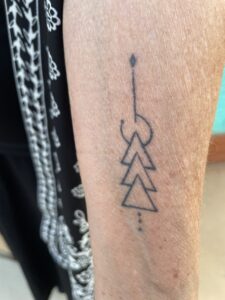by Winding Pathways | Oct 26, 2023 | (Sub)Urban Homesteading, Garden/Yard, Nature, Trees

Magnet bur oak in front yard
We didn’t intend to create a magnet when we planted a skinny bur oak in our front yard 13 years ago.
It created a startling experience one October evening when Marion went to the porch to check the weather. A large furry form dropped from the nearby tree and scurried away in the gathering darkness. A woodchuck? Not likely. They work the day shift. Later we caught the mystery animal in the bean of a flashlight as it returned to the magnet tree. A husky raccoon that again retreated in haste when it saw us.
Over the next several days we watched squirrels and woodchucks forage on the acorns. At dusk bucks and does with yearlings eagerly, yet watchfully, gobbled up acorns. In between, turkeys wandered by to forage. Blue jays dropped out of the tree onto the ground and carried off husky acorns to store for winter.
Why Oaks Attract Wildlife
Our October oak was a perfect magnet. While most area oaks were acorn-bare, our youthful front yard tree was loaded with them. They were huge, sweet, and free of the weevils that often consume acorns before exiting through tiny holes.
Blue jays, wild turkeys, woodchucks, raccoons, squirrels, and deer consider October acorns prime carbohydrate-loaded food. When few oaks, scattered around, bear a heavy crop, wild animals beeline to those loaded with nuts. That’s why our tree was a magnet drawing in a stream of wildlife until every acorn was consumed.
-

-
Small oak and maple.
-

-
Prolific Bur Oak acorns
-

-
White oak acorns have lower tannic acid.
White oak types have leaves with rounded lobes. These include white, bur, and swamp white oaks. Their big acorns are low in tannic acid and are a prized animal and human food. Most trees only bear a heavy crop every few years with acorns that sprout almost as soon as they hit the ground. If not eaten soon weevils find them.
Black oak types have leaves with pointed lobes. Their acorns are loaded with bitter tannin. Often wild animals only feast on them after nearby sweeter white oak-type acorns have all been eaten. Black oak-type acorns wait until next spring to sprout. Perhaps their tannic acid helps them remain uneaten until they sprout months after falling from the tree.
Optimal Places to Plant Oaks
When planted in an ideal location with full sun and rich soil, an oak will begin producing acorns when it’s seven to ten years old. Our front yard tree had a light crop the past few years, but when it reached its 13th year it was loaded with nuts. It was a true magnet that lured wildlife in from far and wide. We enjoyed watching many animals dine on acorns produced by a tree we planted.
by Winding Pathways | Oct 19, 2023 | Nature, Wonderment
Tattoos to You
Recently we have noted people’s tattoos. How fun and meaningful they are. That has not always been the case. Throughout cultures, in eras past, tattoos have been both shunned and venerated. Dating from 5,000 years ago, in Japanese cultures, tatts identified gangs and slaves. Similar to today in different regions of the world.
On the other hand, ancient Egyptian themes centered on fertility and protection in childbirth, the arts and dance.
European Influence
The Picts and Celts of Scotland and Ireland sported fierce body art that duly impressed the Roman soldiers who admired the virile images and feared the fierce warriors.
Europe’s relation with tattoos has been influenced by the several other cultures that invaded over centuries. Again, its fortunes rose and fell as cultures adopted for signs of wealth or as ways to identify slaves. The sordid history of tattoos associated with Nazis soured Americans on tattoos until more recent years. Today, people of all ages and social statuses sport tattoos. Most have special meaning to the person displaying them.
Here are a few we’ve chatted with people about.
-

-
Each a story
-

-
Loving sentiment
-

-
Mountains and Vases
Kate started the quest for stories at the recent Outdoor Writers Association of America conference at Gulf Shores, Alabama. When she travels she researches tattoo artists in the cities and countries she plans to visit, scans their electronic portfolios, checks their credentials, and connects with them. From standard to fine lines, and from nature to sayings by loved ones, each tells stories important to her and is a memento of trips.
-

-
Rising
-

-
Taking flight
Nature themes are popular. The phoenix theme rising again and a nod to the tattoo owner’s children and the magpie is often interpreted as a sign of good luck.
-

-
Fertility and parenting
-

-

-
Mermaid with tattoo.
Egyptian themes have resonated with librarians and “mermaids!” Harthor, the Goddess of fertility, love, and protection in birth & parenting; the “good luck” scarab beetle; and cats, are always venerated in Egyptian mythology.
-

-
All ages enjoy tattoos
-

-
Power Puffs have super powers.
-

-
This tattoos honors siblings and travel.
-

-
Kansas motto tattoo.
Triangles connect family, Buttercup, of the Powerpuff Girls, the animated TV series from the 1990s inspires humor and superpowers. The State of Kansas motto shines brightly on this man’s arm.
Sailors popularized tattoos in the 1700s when returning from long voyages, especially from the Pacific Islands, sporting elaborate tatts. Of course, soon, royalty had to follow. Purportedly even Winston Churchill and his mother had tattoos.
The popularity of tattoos is on the rise with personalized images and sayings in full display.
by Winding Pathways | Oct 12, 2023 | (Sub)Urban Homesteading, Preparedness
What To Do When No Room At the Inn?

Even bivouac camping can be comfortable.
Basic bivouac camping gear saved our night as we drove along a rainy Ohio Interstate.
We were returning to Iowa from a business trip in New Jersey. The 1000-mile trip is too far for us to make in a day so we normally plan to overnight in a comfortable motel in Ohio or Indiana.
On this recent trip, we didn’t make a reservation in advance, so Marion called motels ahead of us as Rich drove through pelting rain. Bad news. They were all booked for the night.
Bivouac Camping Saved Us!
Our basic bivouac camping gear saved us. Marion spotted West Branch State Park on the map. Not far ahead of us and near the Interstate, we exited just as the downpour subsided. Soon we enjoyed a hot dinner inside a restaurant near our tent.

Lightweight camping gear stashed on the sides of the car.
Although we weren’t on a camping trip, we always carry basic bivouac camping gear just in case we run into a situation like our recent one. Modern backpacking gear is lightweight, compact, and effective. It’s essential for a long trail trek but also takes up little space in the car and comes in handy should camping be necessary.
Here’s what we always slip into the car:
- Small nylon tent and ground cloth. Sturdy pegs (spikes or gutter nails are sturdy, don’t bend and so are useful to hold cords to tie a tent down.)
- Lightweight foam mattresses and sleeping bags.
- Folding chairs.
- Cooking and food gear that includes:
* Tiny featherweight butane stove and fuel bottle
* A few backpacking-type meals
* Basic utensils
* Matches! (Remember these!)
Cooking gear and dried meals fit in a small cardboard box and it’s easy to stash the other gear here and there in the car.
-

-
Looks like a lot! It’s not!
-

-
Essentials in box
The morning after our unplanned campout we woke well-rested, sipped instant coffee, packed up, found a breakfast cafe, and were soon back on the Interstate heading home.
A Note on Dried Food
Years ago, dried camping food was tolerable but hardly tasty. That’s changed. Modern foods are delicious. We keep two weeks of dried meals in our preparedness bin at home. Should we be impacted by a natural disaster we’d break out our camping stove and enjoy tasty meals. Although this food lasts for years we occasionally eat a few meals at home, on planned camping trips, and during emergencies. Then we restock with fresh meals. We have previously written about preparedness on our blogs.
by Winding Pathways | Oct 5, 2023 | (Sub)Urban Homesteading
Stuff and Clutter
Frank Lloyd Wright and Henry David Thoreau never met but would have agreed on clutter.
We recently toured Cedar Rock; a home designed by Wright near
Quasqueton, Iowa. Lilly, our tour guide, explained that the famous designer disliked garages and basements. “They gather clutter,” she said.
Thoreau once said, “Things are more easily acquired than got rid of.”
Acquiring Stuff
Modern Americans would have trouble living in a Frank Lloyd Wright home because there’s no place to store their acquired stuff. They’ve probably never heard of Thoreau’s wisdom.
As we drive around, we see open-door garages piled high with stuff – clutter, while an expensive car is parked outside in the weather. Inside, closets brim with rarely worn clothes. Sometimes we even see parked cars brim full of all sorts of rarely used things – stuff.
More Storage Means More Stuff
We’re amazed at the proliferation of rows of rented storage buildings. They seem to be everywhere. Probably they’re filled with items a family never uses but just can’t seem to part with.
If a family thinks they need something, odds are they’ve forgotten where it is. If they remember they may not be able to find it in the heap of clutter. And, if they can find it it’s likely broken or dated. So, people buy a new one that likely will eventually become more stuff tossed on the pile or crammed into a closet.
Clutter Strategy
Our clutter strategy comes from two sources: raising two kids in a garage-less 750-square-foot house, and, cleaning out others’ homes full of stuff. The rule was, that when something comes into the house, something must leave.
We like clothes, tools, and recreational equipment but if we haven’t used something in a while it goes. We can be ruthless in this. Only rarely have we thought, “Oops, we could have used that.” We also keep bins with emergency items that we recycle periodically.
Items we no longer use but are in good repair, we give away or sell. Broken and out-of-date items go to the landfill. Success is empty space in closets and drawers. The house is more tidy, spacious, and lighter. We easily locate what we need. Life is simpler. We find that in today’s consumer-frenzied life, both Frank Lloyd Wright’s and Henry David Thoreau’s wisdom is useful.
Good Yankee Saying

Words of Wisdom
by Winding Pathways | Sep 21, 2023 | (Sub)Urban Homesteading, Flowers/Grasses, Foraging, Nature
By September our thoughts and actions turn to autumn – fall sports, raking leaves, and cozy weekend campfires. For wildlife, especially pollinators late summer and early autumn are critical times to gather nourishment for migrations or hunkering down for winter’s scarcity.
-

-
Foraging
-

-
Feeding on nectar.
-

-
Insects find flowers.
-

-
Busy at work.
On our daily walks, often in the early morning to avoid late-season heat, we notice and appreciate late bloomers and nut abundance. Nectar is an important food supply for pollinators who busily forage among flowers. When the weather cools, pollinators are out later in the day as the sun warms the air. Remember, there is a “night shift” of pollinators, too, who need flowers to feed from.
Here are some late-blooming flowers we have seen on walks or that we nurture in our yard.
-

-
cultivated flowers work, too.
-

-
Roadside blooms are important.
-

-
Color contrast.
-

-
Some flowers prefer low lying areas to grow.





























